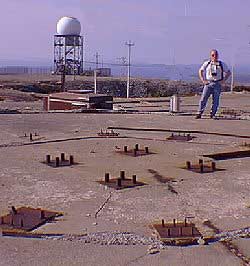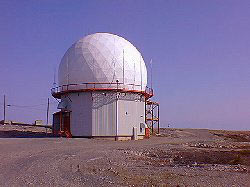Pinetree Radar Site
This page is from a heritage partnered project. It was written in 1998 by students from Stephenville Integrated High School and edited by their teachers. It has not been vetted by the heritage website's academic editor.
Pine Tree Radar Site is one of the three warning systems that was selected when NORAD decided to build Aircraft Control and Warning Stations (AC&W). Stretching from Greenland to the arctic, and along the eastern sea-board, these systems would provide the northern hemisphere with a necessary air umbrella. The other two warning systems were the DEW line and the Mid Canada Line that ran right through the centre of Canada.

However, when the 64th Air Division took over the Northeast Air Command in 1960 they determined that there were gaps in the warning systems. Therefore, smaller AC&W sites, called Gap Fillers, were built along the Labrador coast and in Newfoundland to fortify the Pine Tree Radar Site. Sites for all the AC&W stations had to be on the highest altitude possible in the given location. This was to eliminate any type of surface interference with the delicate and sophisticated radar equipment. Each station had a fair-sized acreage and all permanent buildings had to be constructed. Those in the far north required the capabilities to operate in more than extreme cold conditions. Because of their elevation, each station was subject to severe winds, excessive snow accumulation and extreme low temperatures.
Other Structures
It was necessary to include such structures as dormitories, shops, warehouses, dining halls and recreational buildings, as well as the operations centre at Pine Tree Radar Site. Some had to have interconnecting tunnels, or above-ground interconnections, between buildings. Although most of the large stations had an air force base nearby for logistical support each facility was more or less left on its own. Each of the various buildings were used daily to provide necessary facilities for every worker. Entertainment was the main highlight of Pine Tree. There were dances, celebrations, band performances, and lots of people in clubs as well as the Mess Hall. Every building was important in making Pine Tree a Community within itself.
Work and Life at Pinetree
Life at the site was somewhat hectic at times, but quite enjoyable at others. Each day workers followed strict rules regarding the restricted areas that were top secret and making sure that everything was under perfect control.
"Sometimes jobs such as these could get boring and I would often find myself playing little tunes on my ole' harmonica," says Larry Smith, former non-commissioned officer of Pine Tree. "However, I soon learned my lesson of that and stuck to the task at hand."
There were workers for every area of the site possible and certainly no shortage of jobs. Maintenance workers as well as electricians who did work in the power plant were extremely important in keeping the station up and running as well as fixing and refueling equipment. Of course, there were other jobs such as cooks, office and store workers. In addition, those who worked with other services like entertainment were also just as important. However, weather was often an obstacle that could possibly interfere with each worker's schedule. Often snow storms prevented people from traveling to and from Pine Tree. Shift-workers would have to remain at the bottom of the hill until communication with the present workers stated otherwise. If risks were taken, accidents could result in injury and even death.
Weather Troubles
"Intense cold and severe winds combined to hamper operations and maintenance as well as cause destruction. Magnetic variables in this area made compasses unreliable, thus navigation problems were complex."
Such an incident occurred years ago when a wind arose so fierce that the top story of the barracks was blown right off. Many of the workers' lives were in danger because of this storm. However, it was not all work. The base provided extensive entertainment. Soldiers, along with the workers, would gather at a club, or at the Mess Hall on the site. They played games, socialized and had a great time. There were special bands such as the 535th Air Force Band that performed at concerts, parades and civic functions in Stephenville and other neighboring communities. Many local bands played for dances and other events, as well.
"There was certainly no shortage of excitement along with devastating moments," recalls Mr. Howard Janes, the first Canadian to work thirty one years with the American Air Force.
Phasing out Pinetree
The phase out of Pine Tree was apparent by 1960. The change was brought about by the introduction of long-range equipment, and the greater capability of refueling long-range aircraft in the air. Before rising technology took over, laborers were used to the fullest in every area possible. Radar specialists, firefighters, heavy equipment operators, maintenance men, cooks and helpers all made up the self-sufficient organization. Technology replaced human jobs and did the work faster and more efficiently. Although millions of dollars were spent on labor and equipment to establish a great North American defense organization, the equipment eventually became obsolete.

There remains in the hearts of Pine Tree's surviving workers many unforgettable memories of an era and a lifestyle now passed.




